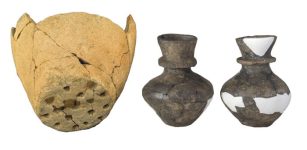Ruins Of The Mysterious Kingdom Of Guge That Suddenly Vanished Overnight
A. Sutherland - AncientPages.com - More than 1,000 years ago, the mysterious great Buddhist Kingdom of Guge, with its capital, Tsaparang, was located on the high Tibetan plateau.
Almost legendary Kingdom was situated in the western part of the Tibetan province of Ngari, about 1200 miles west of Lhasa, close to Mount Kailash, and near the border with India.
Tsaparang, the ruins of the ancient capital of Guge. source
"Ngari" means 'Top of the Roof of the World'. The region in the vicinity of the legendary Guge kingdom is mainly covered with desert and fantastic clay forests extending several hundred square kilometers. Their shape variety is unique. There, in Zhada County, lived a splendid civilization through the centuries.
Almost never-ending strange clay forests surround the county's town and the ruins of Guge. These peculiar forests are formed due to erosion and are composed of clay and sandstone.
Today there are only inaccessible and yet fascinating ruins that cover an area of 720,000 square meters and lie 3800 meters (12400 feet) above sea level!
The mysterious Buddhist Kingdom of Guge - founded in the 10th century by the descendant of the last Emperor of Tibet - is mentioned in ancient Tibetan myths and the famous legend of the lost valley of Shangri-La.
 The extensive Guge kingdom ruins - Image credit: Places of Interest in Tibet
The extensive Guge kingdom ruins - Image credit: Places of Interest in Tibet
In western Nepal's remotest part of Tibet, there is the most sacred place for Hindus and Buddhists: the holy mountain, Kailash, around which legends have gathered for centuries, perhaps millennia.
'...across the high plateau of Tibet... there are inaccessible ruins of the mysterious medieval Buddhist kingdom of Guge, the lost realm of the west which may be the model behind one of the most ancient Tibetan myths, and ultimately, of the famous legend of the lost valley of Shangri-La...' (M. Wood, In Search of Myths & Heroes: Exploring Four Epic Legends of the World).
What is so mysterious about the Guge Kingdom? Probably, the mystery of Guge is connected to its sudden disappearance.
The Kingdom survived for approximately 700 years before it mysteriously disappeared.
The history of Tibet is complex, and "although a unified Tibet was not to last, the establishment of a priestly caste with equal status to that of the aristocracy remained.
The Kingdom of Guge was established in the west, while the Kingdom of Tsang grew up around Shigatse. In central Tibet, a new religious sect emerged in the 15th century.
The reforming Gelukpas, the 'Order of the Model of Virtue' – known colloquially as the 'Yellow Hats,' became increasingly powerful with Mongol support and, in the 17th century, were strong enough to challenge the long-established 'Red Hat' sect of the Kagyupas who had the support of the King of Tsang.
Gelukpa's victory in the bitter conflict with the Kagyupas was far from certain until they sought help from Gushri Khan, the Mongol leader." (Harrison P., Dennis P., Fortress Monasteries of the Himalayas).
Image credit: yuen yan - https://www.flickr.com/photos/yuenchiyan/6122716691/ - CC BY-SA 2.0
For many decades, the ruins of the Guge Kingdom have attracted numerous tourists, archeologists, photographers, and explorers from around the world.
People are not only interested in the culture and art of the Guge Kingdom but also in the mystery of how such a vast kingdom was gone overnight.
Not much is known about what did happen to this glorious Tibetan culture and the more than ten thousand inhabitants of Guge. No descendants survived; with them, much of the Kingdom's history was also lost.
However, several significant Buddhist doctrines had their roots in the Tibetan Kingdom of Guge. There are also murals, tunnels, secret paths, caves, and ancient walls covered with inscriptions and sculptures from the past, and this legacy tells about the Guge Kingdom.
Ruins of the Guge capital at Tsaparang of Guge. Image credit: squallgold - CC BY-SA 4.0
All that is left from the glorious time are the ruins, but even today, the Kingdom's glorious past is still visible. The ruins extend around the sides of a mountain, probably more than 300 m. (984 ft.) high. More than 400 rooms, some fortresses, pagodas, and 800 caves have been located among the Guge's ruins.
There is a rich diversity of old burial places.
According to the ancient Tibetan historical records and the Annals of Kings and Officials in Tibet, Guge had a total of 16 kings who ruled the Kingdom and had their royal, more than 300 meters high, palace - resting on the citadel. But the only way to reach the king's ancient seat was through a labyrinth of passages.
The palace was built in many stages over a long time between the 10th and 16th centuries. In the seventeenth century, a critical period in the history of Tibet came, and the Kingdom finally collapsed.
Written by – A. Sutherland AncientPages.com Staff Writer
Updated on December 11, 2022
Copyright © AncientPages.com All rights reserved. This material may not be published, broadcast, rewritten or redistributed in whole or part without the express written permission of AncientPages.com
Expand for references
More From Ancient Pages
-
 Ostracism: Political Practice In Ancient Athens
Ancient History Facts | May 7, 2019
Ostracism: Political Practice In Ancient Athens
Ancient History Facts | May 7, 2019 -
 Hephaestus (Hephaistos) – God Of Fire And Master Craftsman Constructed Talos, First Greek Robot And Divine Weapons Of The Gods
Featured Stories | Jul 7, 2018
Hephaestus (Hephaistos) – God Of Fire And Master Craftsman Constructed Talos, First Greek Robot And Divine Weapons Of The Gods
Featured Stories | Jul 7, 2018 -
 Zagros Mountains: Home To Tribes, Kingdoms And Empires For Thousands Of Years
Civilizations | Sep 16, 2020
Zagros Mountains: Home To Tribes, Kingdoms And Empires For Thousands Of Years
Civilizations | Sep 16, 2020 -
 Lost Mayan City Hidden Deep In The Peten Jungle Discovered By Expedition Team
Archaeology | Mar 21, 2022
Lost Mayan City Hidden Deep In The Peten Jungle Discovered By Expedition Team
Archaeology | Mar 21, 2022 -
 Why Were Medieval People Easily Offended And Scared Of Rumors?
Ancient History Facts | Oct 14, 2019
Why Were Medieval People Easily Offended And Scared Of Rumors?
Ancient History Facts | Oct 14, 2019 -
 Extraordinary 1,000-Year-Old Viking Sword Discovered In Cork, Ireland
Archaeology | Sep 29, 2017
Extraordinary 1,000-Year-Old Viking Sword Discovered In Cork, Ireland
Archaeology | Sep 29, 2017 -
 Daily Life Of A Lady In Waiting – A Dangerous Profession Sometimes
Ancient History Facts | Aug 24, 2023
Daily Life Of A Lady In Waiting – A Dangerous Profession Sometimes
Ancient History Facts | Aug 24, 2023 -
 Thirsty Wheat Needed New Water Management Strategy In Ancient China
Archaeology | Nov 10, 2022
Thirsty Wheat Needed New Water Management Strategy In Ancient China
Archaeology | Nov 10, 2022 -
 Puzzling Jewellery From Grave Of High Status Viking Woman Delivered At Museum’s Door
Artifacts | Jul 23, 2022
Puzzling Jewellery From Grave Of High Status Viking Woman Delivered At Museum’s Door
Artifacts | Jul 23, 2022 -
 Did Ancient Civilizations Possess Knowledge Of Time Travel?
Ancient Technology | Sep 17, 2018
Did Ancient Civilizations Possess Knowledge Of Time Travel?
Ancient Technology | Sep 17, 2018 -
 First Cemetery Dated To Roman Period Discovered In North Saqqara, Egypt
Archaeology | Nov 12, 2019
First Cemetery Dated To Roman Period Discovered In North Saqqara, Egypt
Archaeology | Nov 12, 2019 -
 Ancient Maps Reveal What Will Happen With Our Climate In The Future – Scientists Say
Archaeology | Oct 12, 2022
Ancient Maps Reveal What Will Happen With Our Climate In The Future – Scientists Say
Archaeology | Oct 12, 2022 -
 Mysterious Balochistan Sphinx Has An Ancient Story To Tell – But Is An Advanced Ancient Civilization Or Mother Nature Hiding Behind The Story?
Featured Stories | Feb 3, 2018
Mysterious Balochistan Sphinx Has An Ancient Story To Tell – But Is An Advanced Ancient Civilization Or Mother Nature Hiding Behind The Story?
Featured Stories | Feb 3, 2018 -
 Neanderthals Had Older Mothers And Younger Fathers Compared To Modern Humans
Archaeology | Apr 23, 2020
Neanderthals Had Older Mothers And Younger Fathers Compared To Modern Humans
Archaeology | Apr 23, 2020 -
 Neolithic Ceramics Reveal Dairy Processing From Milk Of Multiple Species
Archaeology | Mar 15, 2023
Neolithic Ceramics Reveal Dairy Processing From Milk Of Multiple Species
Archaeology | Mar 15, 2023 -
 Unlocking The Secrets Of Lost Prehistoric Land Hidden Beneath The Sea
News | Sep 8, 2015
Unlocking The Secrets Of Lost Prehistoric Land Hidden Beneath The Sea
News | Sep 8, 2015 -
 DNA Study Shows Pre-Historic Wallacea Was A Melting Pot Of Human Genetic Ancestries
Archaeology | Jun 9, 2022
DNA Study Shows Pre-Historic Wallacea Was A Melting Pot Of Human Genetic Ancestries
Archaeology | Jun 9, 2022 -
 Incredibly Well-Preserved 2,000-Year-Old Statue Of Greek God Hermes Found In Heraclea Sintica, Bulgaria
Archaeology | Jul 12, 2024
Incredibly Well-Preserved 2,000-Year-Old Statue Of Greek God Hermes Found In Heraclea Sintica, Bulgaria
Archaeology | Jul 12, 2024 -
 Mysterious And Magnificent Pasha Gardens Built For Unknown Reasons
Featured Stories | Oct 8, 2018
Mysterious And Magnificent Pasha Gardens Built For Unknown Reasons
Featured Stories | Oct 8, 2018 -
 Bezvodovka: Little Known Ancient Solar Observatory In Ukraine Reveals Its Secrets
Archaeoastronomy | Jan 4, 2017
Bezvodovka: Little Known Ancient Solar Observatory In Ukraine Reveals Its Secrets
Archaeoastronomy | Jan 4, 2017



